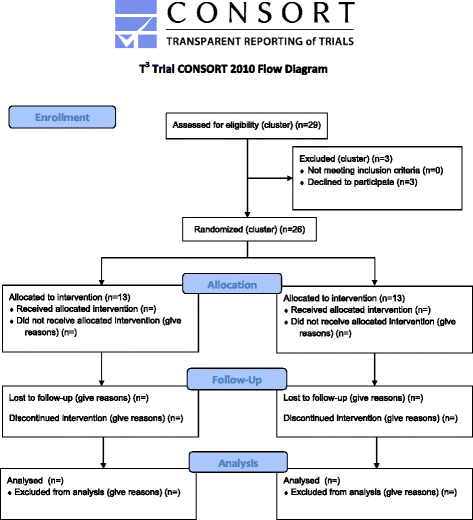Triage, treatment and transfer of patients with stroke in emergency department trial (the T3 Trial): a cluster randomised trial protocol
- PMID: 27756434
- PMCID: PMC5069775
- DOI: 10.1186/s13012-016-0503-6
Triage, treatment and transfer of patients with stroke in emergency department trial (the T3 Trial): a cluster randomised trial protocol
Abstract
Background: Internationally recognised evidence-based guidelines recommend appropriate triage of patients with stroke in emergency departments (EDs), administration of tissue plasminogen activator (tPA), and proactive management of fever, hyperglycaemia and swallowing before prompt transfer to a stroke unit to maximise outcomes. We aim to evaluate the effectiveness in EDs of a theory-informed, nurse-initiated, intervention to improve multidisciplinary triage, treatment and transfer (T3) of patients with acute stroke to improve 90-day death and dependency. Organisational and contextual factors associated with intervention uptake also will be evaluated.
Methods: This prospective, multicentre, parallel group, cluster randomised trial with blinded outcome assessment will be conducted in EDs of hospitals with stroke units in three Australian states and one territory. EDs will be randomised 1:1 within strata defined by state and tPA volume to receive either the T3 intervention or no additional support (control EDs). Our T3 intervention comprises an evidence-based care bundle targeting: (1) triage: routine assignment of patients with suspected stroke to Australian Triage Scale category 1 or 2; (2) treatment: screening for tPA eligibility and administration of tPA where applicable; instigation of protocols for management of fever, hyperglycaemia and swallowing; and (3) transfer: prompt admission to the stroke unit. We will use implementation science behaviour change methods informed by the Theoretical Domains Framework [1, 2] consisting of (i) workshops to determine barriers and local solutions; (ii) mixed interactive and didactic education; (iii) local clinical opinion leaders; and (iv) reminders in the form of email, telephone and site visits. Our primary outcome measure is 90 days post-admission death or dependency (modified Rankin Scale >2). Secondary outcomes are health status (SF-36), functional dependency (Barthel Index), quality of life (EQ-5D); and quality of care outcomes, namely, monitoring and management practices for thrombolysis, fever, hyperglycaemia, swallowing and prompt transfer. Outcomes will be assessed at the patient level. A separate process evaluation will examine contextual factors to successful intervention uptake. At the time of publication, EDs have been randomised and the intervention is being implemented.
Discussion: This theoretically informed intervention is aimed at addressing important gaps in care to maximise 90-day health outcomes for patients with stroke.
Trial registration: Australian and New Zealand Clinical Trials Registry ACTRN12614000939695 . Registered 2 September 2014.
Keywords: Care bundle; Cluster randomised trial; Dysphagia; Fever; Hyperglycaemia; Implementation science; Nurse-led; Stroke; Theoretical domains framework; Thrombolysis.
Figures
References
-
- Canadian Stroke Network. The quality of stroke care in Canada. Ottawa: Canadian Stroke Network; 2011.
-
- Jauch EC, Saver JL, Adams HP, Bruno A, Demaerschalk BM, Khatri P, McMullan PW, Qureshi AI, Rosenfield K, Scott PA. Guidelines for the early management of patients with acute ischemic stroke: a guideline for healthcare professionals from the American Heart Association/American Stroke Association. Stroke. 2013;44:870–947. doi: 10.1161/STR.0b013e318284056a. - DOI - PubMed
Publication types
MeSH terms
Substances
Associated data
LinkOut - more resources
Full Text Sources
Other Literature Sources
Medical


